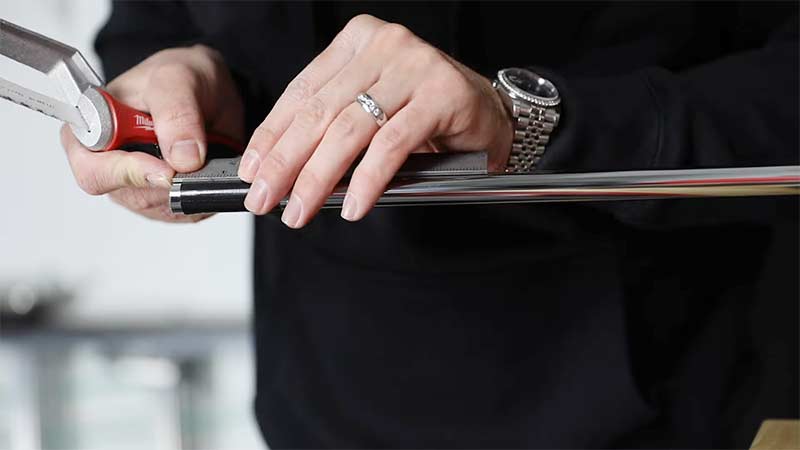Thinking about cutting down your golf driver shaft? It’s a decision that can significantly impact your game. While it might seem like a straightforward process, altering the length of your driver shaft can change the club’s feel and performance.
When you reduce the length of your driver, you’ll notice a lighter swing weight and a stiffer feel due to the shorter shaft.
To maintain the original feel, you might need to add weight to the clubhead. This adjustment isn’t just about comfort it’s about preserving the club’s structural integrity and performance.
Understanding these changes is crucial before you grab a saw. A well-informed decision ensures you don’t compromise your swing or the club’s effectiveness. So, let’s dive into what you need to know to make the best choice for your game.
Driver Shaft Modification
Driver shaft modification refers to altering the specifications or characteristics of a golf driver shaft to better suit a player’s swing or desired performance outcomes.
Why Modify a Driver Shaft?
Modifying a driver shaft can tailor a golf club to your specific swing style. Reducing the length makes the club lighter and possibly easier to control.
It can lead to better swing accuracy and consistency, particularly for golfers struggling with longer shafts. Shortening the shaft from the butt end ensures launch characteristics remain stable. This tweak might suit golfers aiming for ball trajectory control.
However, it’s essential to consider the trade-offs. A shorter shaft can result in decreased clubhead speed, potentially reducing overall distance. Always consult with a professional before making modifications to ensure optimal performance.
Risks and Benefits of Cutting Down a Shaft
Cutting down a shaft carries both risks and benefits. The primary benefit is increased control. A shorter shaft translates to a stiffer feel, aiding precision in your shots.
With a reduction in length, the club loses about 12 swing weight points, making it feel lighter. This could either improve your swing or make it feel too light, affecting performance.
On the downside, modifying the shaft can alter the club’s balance. The head’s weight might need adjustment to maintain original swing weight.
There’s also a risk of reducing the shaft’s overall durability if done incorrectly. Carefully evaluate these factors before making any decisions, using the right golf-specific tools for best results.
How Cutting Affects Performance
Cutting a golf driver shaft, or any golf club shaft, can significantly impact its performance in several ways:
Impact on Swing Speed
Cutting down your driver shaft impacts swing speed significantly. A shorter shaft usually results in a reduced swing speed because you’re covering less distance in your swing arc.
For many golfers, especially those with slower swing speeds, this reduction can lead to decreased ball speed and, consequently, shorter drives.
Data shows that each inch removed might decrease swing speed by approximately 1.5%. However, this trade-off often enhances control and precision, especially for recreational players who might struggle with maintaining accuracy using longer shafts.
Changes to Flex and Feel
Shortening your driver shaft alters the flex and feel of the club. When you cut the shaft, it becomes stiffer because the beam length is shorter but the head weight remains constant.
This increased stiffness can lead to a more linear and controlled ball flight, but it might also require an adjustment period if you’re not used to the new feel.
Additionally, a shorter shaft reduces the total weight of the club and lowers the swing weight, making the head feel lighter. If the shaft isn’t already installed in the club, adjustments are simpler and can be fine-tuned.
Heavier head weights or lead tape can be added to make up for any loss in feel and flex, ensuring the club performs as intended.
Step-by-Step Guide to Cutting a Driver Shaft
Cutting a driver shaft requires careful precision to ensure that the resulting club performs as desired.
Here’s a step-by-step guide to cutting a driver shaft:
Tools and Materials Needed
Ensure you have the proper tools and materials before starting.
You’ll need:
- Fine-tooth hacksaw or Dremel tool: For precise cuts on the shaft.
- Masking tape: To mark the cutting point and prevent splinters.
- Ruler or measuring tape: To measure the exact length to remove.
- Vice with shaft clamp: To secure the shaft during cutting.
- File or sandpaper: To smooth the cut edges.
- Safety gloves and goggles: For protection from debris.
- Replacement weights: To adjust the swing weight post-cutting.
Preparation and Safety Tips
Proper preparation and safety measures are crucial.
Follow these tips:
Mark the Cut Point
Use masking tape to wrap around the shaft where you’ll cut. The tape helps prevent splintering and provides a clear guide.
Always use a fine-tooth hacksaw or rotary cutting tool for precision. After cutting, make sure to sand down the edges to avoid any rough spots that could affect performance.
Secure the Shaft
Place the shaft in a vice with a shaft clamp. Ensure it’s tightly secured to avoid movement during the cut. Using a hacksaw or a specialized shaft cutter, carefully cut the shaft to the desired length. Smooth the cut edge with a fine-grit sandpaper to avoid splinters or damage.
Clean the area thoroughly to remove any metal shavings. After cutting, ensure the club’s grip is reinstalled correctly. Adjust your swing or consult a professional to fine-tune performance.
Safety Gear
Wear safety gloves and goggles to protect from splinters and debris. Secure your work area to prevent accidents. Measure the desired length carefully before making any cuts.
Use a fine-toothed saw or a specialized shaft cutter for precision. After cutting, smooth the edges with sandpaper to avoid future wear.
Measure Twice, Cut Once
Double-check your measurements before cutting. Removing too much can’t be undone. Also, be aware that shortening the driver shaft can alter the club’s swing weight, affecting performance. Consulting with a professional can ensure the best results and maintain your game’s integrity.
Smooth the Edges
After cutting, use a file or sandpaper to smooth the edges, preventing any damage to your grip. Be sure to reattach the club head securely and check the balance. Adjusting the swing weight might be necessary to maintain optimal performance and feel on the course.
Professional Insights on Shaft Modification
To gain professional insights on shaft modification, consider reaching out to experienced club fitters, professional golf instructors, or individuals with expertise in golf equipment customization.
These professionals can offer valuable perspectives based on their knowledge and experience in the golf industry.
Here’s how you can gather insights:
Expert Opinions
Experts agree that modifying a driver shaft impacts overall club performance. Shortening the shaft enhances control but decreases swing speed.
For example, most PGA Tour players use a 45-inch driver, while some experiment with the USGA limit of 48 inches to gain extra speed.
Golfing authority sources emphasize, though, that recreational players benefit more from shorter shafts, which provide better control and more consistent performance.
Industry veterans recommend cutting the shaft from the butt end to preserve launch characteristics and trajectory.
Case Studies and Comparisons
Golfers like Bryson DeChambeau and Adam Scott have tested long drivers nearing the 48-inch limit, focusing on increased speed.
While they see success, their high skill levels allow them to control these longer clubs. For comparison, Phil Mickelson uses a 47.5-inch driver to gain distance.
However, average players often find longer drivers lead to bigger misses. Shorter drivers, around 43.5-44.5 inches, improve control and precision for most golfers.
By observing changes in trajectory, swing weight, and overall feel, these case studies guide players in deciding whether to modify their driver shafts.
Frequently Asked Questions
Is a 3 wood shaft just a cut down driver shaft?
Fairway wood shafts are shorter than driver shafts and are trimmed more from the tip-end near the clubhead to the desired length before installation. This trimming makes the shaft stiffer to counteract the heavier weight of a fairway wood head.
Can I shorten the shaft on my driver?
Yes, it is an easy task with the proper golf-specific tools. Note that cutting down the shaft will change its flex and feel. Shortening the driver reduces swing weight, making the club “feel” lighter and potentially improving control.
How to cut a driver shaft at home?
For a steel shaft, use a pipe cutter for a clean cut, though it takes longer. Clamp the cutter at the desired cut line, spin it, tighten, and repeat until done. A hacksaw also works but requires a vice and steady hand.
What happens to swing weight when you shorten the shaft?
For every half inch you cut off, the swing weight decreases by about three points. Each point can be restored by adding approximately two grams of weight to the clubhead.
How long is Rory McIlroy’s driver shaft?
Rory McIlroy uses a 45-inch Ventus Black 6X driver shaft. This adjustment helps him control the middle of the face more easily and achieve greater distance.
Conclusion
Modifying your driver shaft can significantly impact your game. Shortening the shaft can enhance control and precision, making it a valuable adjustment for many golfers. However, it’s essential to consider the trade-offs, such as reduced swing speed and changes in swing weight.
Professional insights and case studies show that while longer shafts may benefit highly skilled players, average golfers often see better results with shorter shafts.
Observing how these changes affect your trajectory and overall feel can help you make an informed decision. Ultimately, personalizing your driver shaft to match your swing style can lead to improved performance on the course.








Colin McCarthy